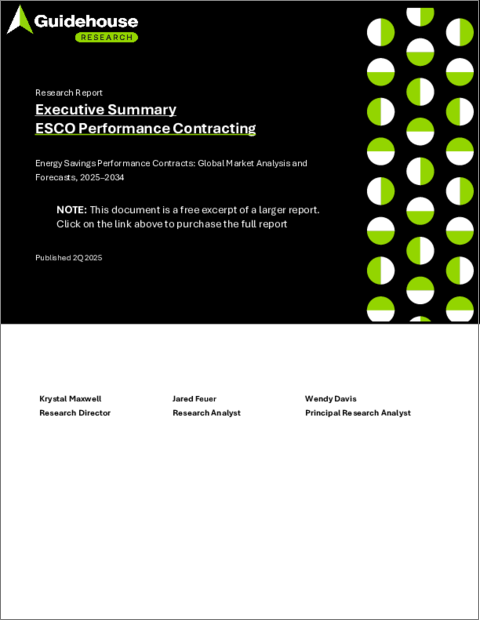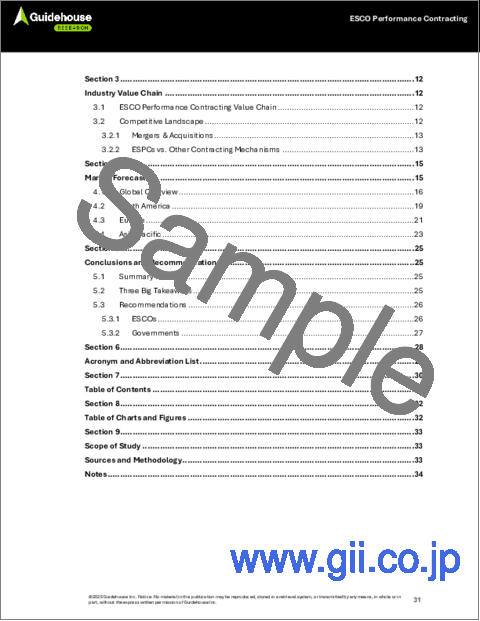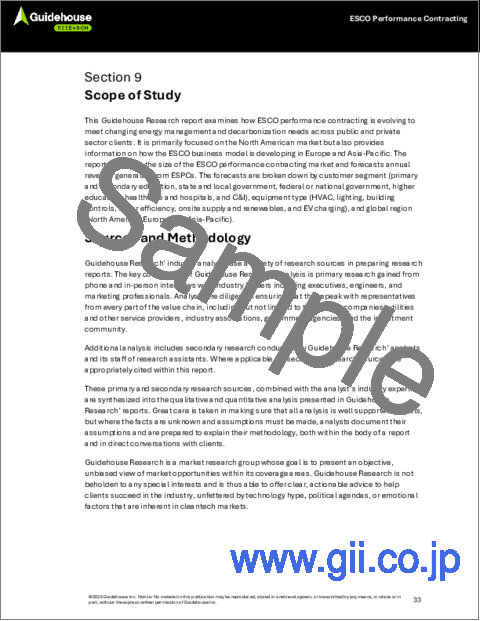|
|
市場調査レポート
商品コード
1734249
ESCO保証契約ESCO Performance Contracting: Energy Savings Performance Contracts - Global Market Analysis and Forecasts, 2025-2034 |
||||||
|
|||||||
| ESCO保証契約 |
|
出版日: 2025年05月20日
発行: Guidehouse Research
ページ情報: 英文 35 Pages
納期: 即納可能
|
全表示
- 概要
- 目次
エネルギーサービス企業(ESCO)が提供する省エネルギー保証契約(ESPC)は、多くの顧客セグメントにおいて、コストの節約、エネルギー効率、インフラのレジリエンスを向上させることができます。ESPCは、連邦政府や地方自治体の建物、病院、教育施設に直接利益をもたらすことができます。その他の受益者には、民間の商工業ビル、ユーティリティ、軍事機関などが含まれます。
ESPCの利用は複数の市場促進要因によって世界的に支えられています。公的機関も民間企業も、ESPCによるコストの節約、インフラのアップグレード、エネルギー効率とレジリエンスの向上に魅力を感じています。ESPC利用のその他の主な促進要因は、企業の脱炭素化目標、法律の制定、建築性能基準、ユーティリティベースのプログラム、エネルギー市場参入インセンティブ、余剰資本を持つ企業などです。しかし、著しい成長にもかかわらず、ESCO保証契約市場は注目すべき障壁に直面しています。持続的な成長は、契約方法としてESPCを利用する利点に対する認識を高めることによって、ステークホルダーが課題に対処できるかどうかにかかっています。
当レポートでは、ESCO保証契約市場について調査し、初等中等教育、州・地方政府、連邦/中央政府、高等教育、医療・病院、商工業の6つの顧客セグメントにおけるESCO保証契約の主要動向を分析しています。また、ESPCで活用されている、顧客のエネルギー効率、コスト削減、インフラ価値の向上を支援する6つの技術についても取り上げています。
目次
第1章 エグゼクティブサマリー
- イントロダクション
- 範囲
- 市場の促進要因
- 市場の障壁
- 世界市場の見通し
第2章 市場の問題
- ESCOの定義
- ESCO保証契約の仕組み
- 省エネルギー保証
- 省エネルギー共有
- 市場の定義
- 技術
- 顧客セグメント
- 促進要因
- コスト削減と老朽化したインフラ
- レジリエンスとエネルギー効率上の利点、持続可能性への取り組み
- 法律の制定、建築性能基準、ユーティリティベースのプログラム
- 需要応答、ネットメータリングのインセンティブ
- 余剰資本を持つ企業
- 障壁
- 政治的不確実性
- 人材ギャップ
- 資本の可用性と長期的なROI
- 低いエネルギー価格
- エネルギー効率を高める機会の減少
第3章 産業バリューチェーン
- ESCO保証契約のバリューチェーン
- 競合情勢
- 合併と買収
- ESPC vs. その他の契約方法
第4章 市場予測
- 世界の概要
- 北米
- 欧州
- アジア太平洋
第5章 結論と提言
- サマリー
- 3つの大きなポイント
- 提言
- ESCO
- 政府
第6章 頭字語と略語のリスト
第7章 目次
第8章 図表
第9章 調査範囲、情報源、調査手法、注記
The energy savings performance contracts (ESPCs) offered by energy service companies (ESCOs) can increase cost savings, energy efficiency, and infrastructure resilience across numerous customer segments. ESPCs can directly benefit federal and municipal government buildings, hospitals, and education facilities. Other beneficiaries include private commercial and industrial (C&I) buildings, utilities, and military institutions.
Multiple market drivers support the use of ESPCs globally. Both public and private entities are attracted to the cost savings, infrastructure upgrades, and increased energy efficiency and resilience that result from ESPCs. Other key drivers of ESPC use are corporate decarbonization goals, enabling legislation, building performance standards, utility-based programs, energy market participation incentives, and companies with excess capital. Yet despite noticeable growth, the ESCO performance contracting market faces noteworthy barriers. Continued growth will depend on stakeholders addressing challenges by increasing awareness of the benefits of using ESPCs as a contracting mechanism.
This Guidehouse Insights report analyzes major trends in ESCO performance contracting across six customer segments: primary and secondary education, state and local government, federal or national government, higher education, healthcare and hospitals, and C&I. It covers six technologies utilized in ESPCs that help customers increase energy efficiency, cost savings, and infrastructure value: HVAC, lighting, building controls, water efficiency, onsite supply and renewables, and EV charging. The report provides an overview of the drivers and barriers for the ESCO performance contracting market and offers recommendations for ESPC stakeholders. Finally, it projects global revenue from ESPCs by region, customer segment, and equipment type from 2025 through 2034.
Table of Contents
1. Executive Summary
- 1.1 Introduction
- 1.1.1 Scope
- 1.1.2 Market Drivers
- 1.1.3 Market Barriers
- 1.2 Global Market Outlook
2. Market Issues
- 2.1 ESCOs Defined
- 2.2 ESCO Performance Contracting Mechanisms
- 2.2.1 Guaranteed Savings
- 2.2.2 Shared Savings
- 2.3 Market Definitions
- 2.3.1 Technologies
- 2.3.2 Customer Segments
- 2.4 Drivers
- 2.4.1 Cost Savings and Aging Infrastructure
- 2.4.2 Resilience and Energy Efficiency Benefits and Sustainability Commitments
- 2.4.3 Enabling Legislation, Building Performance Standards, and Utility-Based Programs
- 2.4.4 Demand Response and Net Metering Incentives
- 2.4.5 Companies with Excess Capital
- 2.5 Barriers
- 2.5.1 Political Uncertainty
- 2.5.2 Talent Gap
- 2.5.3 Availability of Capital and Long-Term ROI
- 2.5.4 Low Energy Prices
- 2.5.5 Diminishing Opportunities to Increase Energy Efficiency
3. Industry Value Chain
- 3.1 ESCO Performance Contracting Value Chain
- 3.2 Competitive Landscape
- 3.2.1 Mergers & Acquisitions
- 3.2.2 ESPCs vs. Other Contracting Mechanisms
4. Market Forecasts
- 4.1 Global Overview
- 4.2 North America
- 4.3 Europe
- 4.4 Asia-Pacific
5. Conclusions and Recommendations
- 5.1 Summary
- 5.2 Three Big Takeaways
- 5.3 Recommendations
- 5.3.1 ESCOs
- 5.3.2 Governments





